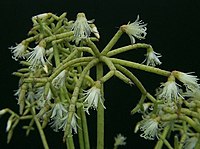
Photo from wikipedia
Abstract The Amazon houses a large proportion of the overall biodiversity currently found on Earth. Despite that, our knowledge of Amazonian biodiversity is still limited. In this study, we reconstruct… Click to show full abstract
Abstract The Amazon houses a large proportion of the overall biodiversity currently found on Earth. Despite that, our knowledge of Amazonian biodiversity is still limited. In this study, we reconstruct the phylogeny of Pachyptera (Bignoniaceae), a genus of neotropical lianas that is centered in the Amazon. We then use this phylogenetic framework to re-evaluate species limits and study the biogeographic history of the genus. We sampled three molecular markers (i.e. ndhF, rpl32-trnL, and PepC) and 51 individuals representing the breadth of morphological variation and geographic distribution of all species recognized in the genus. We used this information to reconstruct phylogenetic relationships among individuals of Pachyptera using Bayesian and maximum likelihood approaches. The resulting molecular phylogeny was used as a basis to test species limits within the P. kerere species complex using a cpDNA coalescent approach (GMYC). GMYC identified five potential species within the P. kerere species complex that were subsequently evaluated in the light of morphology. Morphological data supported the recognition of four of the five potential species suggested by GMYC, all of which were also supported by a multispecies coalescent model in a Bayesian framework. The phylogeny of Pachyptera was time-calibrated and used to reconstruct the biogeographical history of the genus. We identified historically important migration pathways using our comprehensive cpDNA dataset and a Bayesian stochastic search variable selection (BSSVS) framework. Our results indicate that the genus originated in lowland Amazonia during the Middle Eocene, and subsequently occupied Central America and the Andes. Most of the diversification of Pachyptera occurred in the Miocene, a period of intense perturbations in South America.
Journal Title: Systematic Botany
Year Published: 2020
Link to full text (if available)
Share on Social Media: Sign Up to like & get
recommendations!